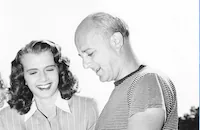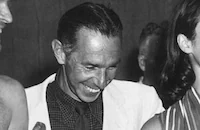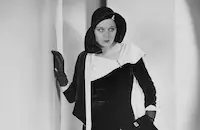Fixer Dugan

Brief Synopsis
Cast & Crew
Lew Landers
Lee Tracy
Virginia Weidler
Peggy Shannon
Bradley Page
William Edmunds
Film Details
Technical Specs

Synopsis
Charlie Dugan is the "fixer" for the Barvin Circus, a fast-talking diplomat who spends most of his time smoothing out arguments with local sheriffs and patrons, as well as patching up internal difficulties among the show's personnel. One such difficulty involves the future of little Terry, whose mother, a high-wire artist, has fallen to her death. Dugan suggests the orphan be put in a foster home, but Terry objects, and when the sheriff takes her away for lack of supervision, Adgie Moreno, a circus lion tamer who feels guilty because she had feuded with Terry's mother before her death, lies to the judge and says she is the girl's mother. Soon after she is adopted into the circus family, Terry overhears Darlow, a representative from their rival circus, and his strongman talk about repossessing Adgie's lions, which they claim Adgie had sold to them according to a contractual agreement. Rushing to warn Adgie, Terry risks her life by entering the lions' cage in the middle of a performance, and is scolded by Adgie for her foolishness. However, because Barvin loved Terry in the act, he instructs Adgie to use her in the future. When Darlow shows up again, Dugan invalidates the ill-gotten contract by crossing the state line, but Darlow retaliates by filing a complaint about Barvin's underaged performer. To everyone's astonishment, Terry is taken to the Marysville Kansas Home for Children, where she is put under the care of superintendent Fletcher. Later, Adgie misses Terry so much that she gets Barvin to re-route the circus so that they can pass through Marysville. The circus troop puts on a performance at the orphanage and after they leave, Terry emerges from a basket in the back of their truck. Adgie admits her complicity in the abduction, but the circus continues nevertheless. Meanwhile, Dugan manages to trick Darlow into selling back the lions. When some of the lions are let loose, Adgie risks her life to save Terry, who had become trapped by the lions. When Mrs. Fletcher learns about Adgie's act of courage, she suggests that she file for adoption again, hinting at the fact that her case may be reconsidered.

Director

Lew Landers
Cast

Lee Tracy

Virginia Weidler

Peggy Shannon

Bradley Page
William Edmunds
Edward Gargan

Jack Arnold

Rita La Roy
Irene Franklin
John Dilson
Edythe Elliott
Sonny Bupp
Crew
James Anderson
Henry Berman
Carroll Clark
Bert Granet
J. Roy Hunt
Lee Marcus
Van Nest Polglase
Cliff Reid
John E. Tribby
Vernon L. Walker
Roy Webb
Paul Yawitz

Film Details
Technical Specs

Articles
Fixer Dugan
Lee Tracy might've been the most conspicuous of the lot--he was a slight, rubber-faced squirt of a man, nothing to look at it until he opened his crooked mouth, which was the size of the great outdoors. Tracy's inimitable way with streaming banter favored raw velocity over nuance, and his approach to a series of wisecracking had a rebellious, youthful esprit, particularly during the pre-Code years. Except Tracy wasn't young--just a few years older than the century, he had the manic drive of a self-destructive alcoholic. In fact, his unlikely stardom in the '30s came under fire when during the making of Viva Villa! in 1933, he supposedly drunkenly peed off his Mexican hotel balcony onto the heads of military cadets. Few Hollywood scandal stories match their subject's persona so beautifully, and while director Howard Hawks saw nothing particularly amiss with this episode, if it in fact happened exactly that way, MGM mogul Louis Mayer had Tracy kicked off the film anyway. (Hawks was also relieved of employment.) From there, Tracy's roles became fewer and slower, and after WWII his career meandered into guest parts in episodic television before landing a plumb role in Gore Vidal's The Best Man (1964), which netted him a valedictory Best Supporting Oscar nomination. Fixer Dugan (1939) is past-prime Tracy; the comic fire of pre-Code chatterboxing is gone, and if he ever seemed an odd choice for a leading man in the early part of the decade, by 1939 his squinty visage and door-hinge voice made for very strange romantic fodder. Or, perhaps, more realistic than Hollywood normally dared, then or now--in the film, Tracy is the manager of a travelling circus, a master at talking anyone out of anything, and so the character's social force and confidence could conceivably make him the object of desire of both bitchy high-wire artist Rita La Roy and sassy lion tamer Peggy Shannon. In any case, the film (adapted from a play by director H.C. Potter, his only writing credit) focuses not on romance but on a vintage mismatch scenario, probably pioneered by Charles Chaplin with The Kid (1921)--La Roy's acrobat falls to her death and leaves her circus-born 11-year-old daughter (Virginia Weidler) an orphan, and the kid becomes the impromptu charge of Tracy and Shannon's semi-couple. The law intervenes, of course, as does a rival circus out to Shanghai Shannon's lions.
Immediately you can sense the attraction of Fixer Dugan--Tracy is fine in a custom-built role, if a little drink-worn by now, but the real gen is the busy, densely inhabited narrative all set within a perfectly believable old-school circus milieu. Movies about circuses, even when they're crummy, can be fantastically seductive, especially in the early century, when the gist of low-rent circus life was still a living memory for many people, and the films could have fun with it without romanticizing it into a myth. Director Lew Landers (who made B movies in the '30s and '40s at the clip of seven or eight a year) is no stylist, but his game is tight here, and the busy, bustling circus milieu is addictive and full of implicit details about circus life--the capacity for the fairway to attract freelance grifters at its fringes; the economic stake made in unruly megafauna; the capacity for the circus to uproot and disappear across state lines in a few hours if conditions are not favorable; the necessity of a "fixer" to constantly adjust, connive and ameliorate disasters; the edge-of-the-law nature of the entire enterprise, etc. It's a fairly elaborate production, with deft trick photography work that puts Shannon in close to the lions, and a backstage mood that feels thriving with life.
Tracy, for his part, handles his title role with well-I-don't-know-'bout-that duplicity, placating every other character in every conversation with lies and half-truths, even the rival outfit's sociopathic henchmen. Against all odds, the irascible-bachelor-&-orphan melodrama works, too, thanks to the witty dialogue that smiles through sniffles, and Weidler's authenticity as a fearless tomboy who loves nothing so much as circus life. Tracy is the star, however, on the brink of war (he fought in WWI, but he reenlisted) and of the demise of his ersatz stardom. He'd go on to make only six films in the '40s--he'd made 30 during the '30s--before toiling in bit roles from there on. He was then a pure product of Depression Hollywood--a branded star, not a comedian, popular exclusively for his articulate sass and verbal speed. Those were the days.
By Michael Atkinson

Fixer Dugan
Quotes
Trivia
The play originally opened in New Haven, Connecticut, USA on 1 May 1928.
Notes
A working title for this film was What's a Fixer For?. Hollywood Reporter production charts list Peggy Carroll, Dorothy Lovett, Jane Woodworth, Ethel Haworth, Richard Clarke, John Laing and Roger Hunt in the cast, but their appearance in the released film has not been confirmed. According to Hollywood Reporter pre-production news items, actor Chester Morris was set for the male lead in the film, and Donnie Dunagan was announced for featured part. Although reviews identify Peggy Shannon's character as Adgie Modeno, in the film she is referred to as both Adgie Moreno and Adgie Moleno. Modern sources list actors Harry Tyler (Mike, Midway ticket seller) and Earle Hodgins (Sideshow barker) in the cast.














